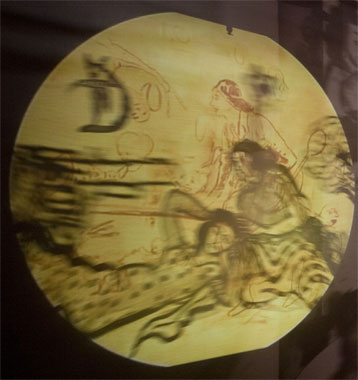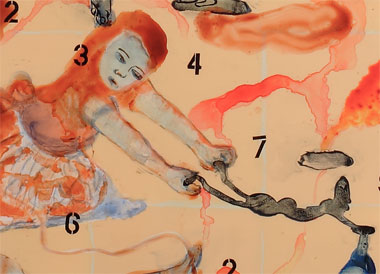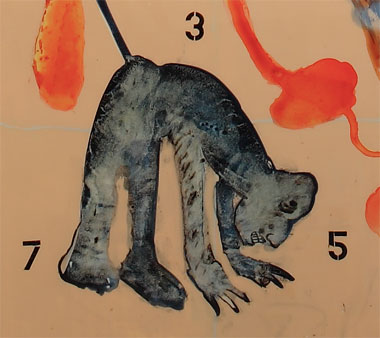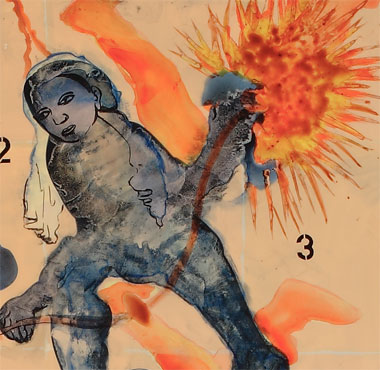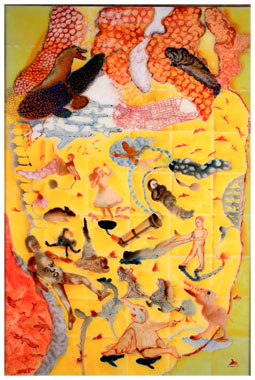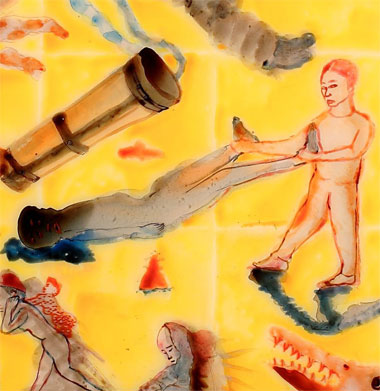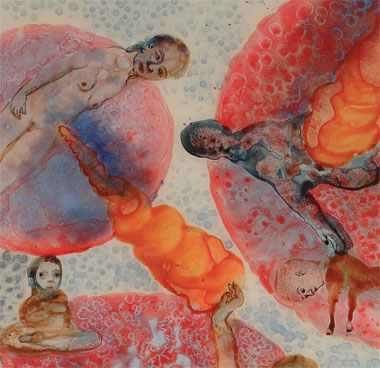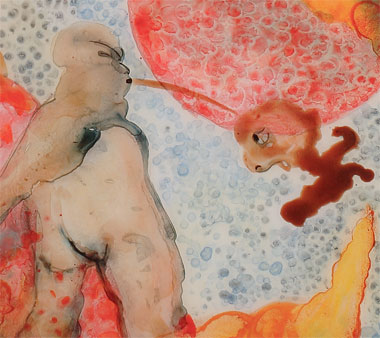This interview was recorded on 9 July 2007, the day before the opening of Nalini Malini’s solo exhibition in IMMA, while the final installations of the show were being completed. The exhibition continues until 14 October.
JG: Nalini, I can see you are fluent in many media; what is this for instance?
NM: It’s polycarbonate…it’s painted in reverse, I do a lot of reverse painting. I will have two other videos at the ends; those videos are animations of the drawings you already see in the shadows. These shadows run through the videos as well, so you have a montage of a low-tech and a high-tech.
JG: Where did your inspiration for this piece come from?
NM: It’s called Remembering Mad Meg; you can see Mad Meg there. Most of my characters are female and more or less deviants. That’s her.
JG: I believe these pieces were done especially for this exhibition; why are they called so?
NM: Yes, they were. Mad Meg was a character in a Breugel painting, which is in Antwerp now. It’s not a very large painting; it’s about 75 centimetres high by about a metre wide. You see this figure, this woman who almost looks like an androgynous figure striding across a landscape of completely perverted things around her, for example, there is an egg-like humanoid eating through his anus. It’s almost like she is seeing all of this and somehow wants to put things right but then she is considered the deviant. Nalini laughs.
JG: Could we talk about the female figures and who they are?
NM: These are paintings based on various female protagonists. This one is called Appeasing Radha . Radha was a mythical figure in the Hindu myths, they are just stories about one thing and another, very much like the Greek stories. She (Radha) was married but she loved Krishna, but it was an adulterous relationship. She would step out of her house very quietly…women in India wear bells around their ankles, you see.
JG: That’s right, they have a potent symbolism.
NM: They have a double function, as a decorative ornament, but they also let the mother in-law know where her daughter is. So Radha walks out of the house on tiptoes in order to have this tryst with her lover in the forest. He is younger than her and a cowherd. There is this whole thing about the erotic and the sacred, so this painting is based on this story of Radha.
JG: Nalini, you paint the outside of the body and then the inside, it’s as if you defragment the human form.
NM: You know, the human being has so many parts in him or her and every part of the body has some emotion. Yes, I use a lot of kidneys and also the brain. At my age I know quite a number of people, friends who have contracted cancer and for long periods of time you invest in that organ which is cancerous all sorts of emotions, and then the organ itself becomes a palpable living object, more separate and this cancerous cell is just growing and growing and growing, it’s almost like having this strange entity inside of you. Three years ago a close friend and artist passed away because he had prostrate cancer – Enrique Junquosa actually had a show in the Reina Sofía in Spain for him. He was just in his early seventies and looking forward to so much and then suddenly this thing took over and his life came almost to an end. He kept saying ‘Why me, why me?’ – every body says that. So all of these things have had resonances in my paintings.
JG: Your paintings have a room to themselves in Italian Pavilion in Venice this year; I sat for some time there, it was raining and late into the day and I noticed another figure, a little girl – is she Alice in Wonderland? I have read that there is a pattern with her in your work for some time now.
NM: Alice appears now and again in various forms, as a girl from India, bare-footed and cleaning the floor. Nalini laughs. In previous years I do have the little girl, but at that time it wasn’t so much the Alice figure but more to do with the indigenous Indian body; it’s fall of that body that I was interested in. Somehow family situations leant themselves to talking about that particular class environment. India was a young country then, it still is a young country, only sixty years old. So all of these things have been important for artists, at least my generation of artists.
JG: And who is she?
NM: She is Akka. And this painting is also called Akka ? Do you know about her?
JG: No, I haven’t heard of her.
NM: Akka means sister actually, but she was called the Great Sister. At a very young age she was to be married, you know there is child marriage in India?
JG: Yes.
NM: This is the twelfth century in India and she actually protested and said to her parents, a merchant family, “How can you marry me off, when I am already married, I am married to Shiva?”
JG: Is this myth?
NM: No, this is a true story, and so she walked out of her parents’ home, with only her tresses around her. She wrote a lot of excellent poetry about the male gaze. When she would encounter a male who would try to molest her she would say, “Look at the way you look at me, think about that, it’s not me who is exposing herself to eroticism, but it’s your eyes!” She died very young, at 23, but in the wanderings she wrote a lot of poetry. It’s a continuous narrative, you can see images of her all over, and in this exhibition there are several paintings about her. Also, she has been translated into English; you can now read a lot of her translated work.
There are also works in the exhibition on Sita and Medea. Sita was the wife of Ramen; she was abducted by the so-called demon Ramen and taken to Sri Lanka. But just like Medea, a man betrayed her; in this case it was her husband. In the case of Medea, it was Jason who betrays her, as he leaves to marry King Creon’s daughter. In the case of Sita, the people of the Kingdom refuse to believe that another man, maybe the kidnapper, had not touched her. And so, even in spite of Sita, her husband has to abandon her and she has to return to the earth. You see, her Mother was the Earth; she leaves her two small children behind, as does Medea. Well, Medea kills her children and Sita abandons hers. In a way, denying their motherhood degenders them both.
JG: There is a quote in one of the essays in your catalogue explaining your interest in trying to make the invisible ‘visible’.
NM: Actually, my trajectory into art was through my biology teacher at school. The concept of what is an artist didn’t really exist, especially for women. But I was very keen to go to art school, I didn’t have the brains to be a doctor, so she suggested that I start doing medical drawings for textbooks. She taught me how to draw . It wasn’t meant to be a piece of art but how to show things, for example, the blood cycle in the body. How do you show how the lungs move and how a heartbeat works? You see, she was very good at these things herself, during those years we were allowed to dissect things you see, little animals – pigeons and rabbits and so on and so forth, but this experience taught me to draw. And then, when I went to art school, it wasn’t with the idea that I would be an artist but it was more to do with medical drawings, the body, zoology, botany, slicing flowers, and looking at stamens and so on. And this teaching of my biology teacher has stayed with me all these years. Yes, I think it was really excellent, I would even recommend it, if anyone really wanted to start up an art school, it just shows you how nature works.
JG: And does this working process come easily to you?
NM: Now it does, I really enjoy it very much; it’s all on the back. I use a mirror below…as it starts to get more and more dense and opaque I place a mirror on the ground to see what I’ve done, it’s just bit by bit you know… laughs…
JG: Have you been down to the Chester Beatty?
NM: I loved it. I saw some really unusual things there. It’s very well organised. There is one twelfth Century Persian painting, a miniature of Mary with Jesus and, you wouldn’t have thought it had anything to do with Christianity because this woman is wearing red and she is shaking a date palm. There is a baby swathed in clothes and there are golden streaks coming out of it. On the top part of the painting, almost 50 percent of it is blue, it’s the waters, you know because there are little plants growing in it, it’s not the sky. And the inscription says “Mariam resented being impregnated” …laughs… “And so God gave her these cool waters to calm her down and this date palm, so she could get some of her energy back by eating the dates.”
JG: Who are these figures?
NM: This is Akka again, she is wandering, and she has an airplane as a foot. And then you know these are women who are in sport, nowadays there is a contrast, there are so many woman striving to do so much in India and elsewhere, it was never so in the twelfth Century! So it is just to show how things are and how things have moved somewhat but also it’s a bit of a decoy because this is only one aspect, really only a tip of the iceberg on the trip to liberation. I think that what happens is we all have this feeling that we have moved along towards liberation. But I was reading ‘The Pain of Others’ by Susan Sontag, it’s a very fine essay I must say, when she starts to examine photographs of war, photographs of ground zero and the day after 9/11, she examines what it really meant for women to really look at these pictures and it is quite important to realize that so much of what happens to us, what happens to women, is not in our hands, it’s always somebody else who is making our destiny, it is not women who are doing it.
JG: This could be seen as a fatalistic take on life.
NM: Yes, it is always women who have to take care of our dead, of our wounded. In cases where there is change in the balance of nature then you have children who are deformed. You see, whether it is underground testing in India or recently what the French did in Tahiti. Finally, these are things that are not spoken about very loudly and they are just kept hidden away somewhere.
JG: It seems daring to approach so many layers and narratives in your work.
NM: The thing is that there are problems in trying to key in these ideas in a manner, which is not propaganda, which is a big testing ground really. How do you create a work which people will find attractive? That could be the first register and then it is my hope that people can get into the other things that I want to talk about.
JG: Nalini, I want to ask you about the use of the numbers I’ve noticed in several of your paintings.
NM: Yes! This is a fun thing; I started first with the blocks, which we have seen in some of the other paintings. When my children were young we played Snakes and Ladders and Ludo and we used to have a lot of fun with numbers and the numbers kept us within the game. The numbers act as a decoy, to keep you within the picture. You think that there is a logic to the numbers and that you must find out that logic and while you are trying to look, you see, now there’s one and there’s two and there’s three. Now as you do that your eye traverses the picture and sees areas, which you unconsciously notice. That unconscious noticing therefore stays in a different register, rather than when you are actually looking at the people in it. So it’s more to keep you within the picture so that you can see things perhaps in a different way. We all have habits of looking, we all have habits of thinking and sometimes we get a little stuck in our ways of thinking, how do we look at things upside-down?
JG: So there is no logic to the numbers?
NM: No, accept this…. Nalini laughs …
JG: Perhaps, there is no logic to life?
NM: No, there it is, there is no logic to life! It has an irrationality that sometimes plays out.
JG: It is a very extensive show….
NM: There are fifteen paintings, in which there are two triptychs and there is a shadow play. This is the first time I have made a shadow play with eight pieces. When I first started making these cylinders, it was actually for a performance in Bombay. I worked with one performance artist and a theatre director. When I’ve worked in theatre, it’s not the director who directs or I who direct, we work very much together, always women together, we work very much like a warp and a weft. Actually it was a short story of Bertold Brecht, called ‘The Job’, where she has to transform herself into a man, because she has to take the job because her husband has died and she has two children…
JG: Yes, that’s right, I know the story, it’s set in a factory.
NM: Right. In this experimental theatre we didn’t want any blackouts so we thought about ways in which the actress could change. And I said, look I have worked a lot on polyester film and I’ll see how large I can get them, and the actress was just five feet high…so I started to make these cylinders which went over her. We used them like pistons in a factory. I made five of them and they were pulled up and down like pistons during the play. The play starts with these pistons going up and down and they twirled and when they twirled they cast shadows. This I didn’t expect but it happened, so I’m very happy with that.
This again, is Alice, it is a series that has overlapped, and it’s Alice in the streets of Bombay in an area called Lohar Chawl. I have done a lot on Lohar Chawl as I had a studio there for 25 years, it was a loft in the wholesale markets. For me I wanted to see that if I brought this very English girl into this space what would happen? And then it becomes a head, there is a map of Bombay there, and then it becomes a head, do you see there? With a monacled eye…like a young and dandy English man. … Nalini laughs…
JG: Nalini, you rely on overtly Indian themes, found in the Lohar Chawl series for example, you also then step up the pace by also using Western myths and traditions – is it important for you to create work that is accessible?
NM: Yes, and art that’s not too impenetrable.
JG: On this note can we talk a little about Hamletmachine ?
NM: This Hamletmachine from Heiner Muller [1] derives from Shakespeare but he changes a lot of things. It talks about the current situation we are living in, also about hesitancy and not really taking decisions. But for me the metaphor had more to do with the country India which was wavering and not exactly knowing where to go, starting out as a socialist state, pro-Soviet and the completely moving into capitalism, raw capitalism. I was filled with such dismay to see how things were going. And because every time you have the beginnings of capitalism in a country you also find fanaticism raising its head, for example the rise of right-wing Hinduism.
JG: How does this situation impact on your life as an artist?
NM: It affects others and me very much. About one month ago, some students in the art university in Bombay had made a painting of Vishnu for an exam work. The cultural division of the extreme-right group came and took away this work, and suspended the Dean. The whole arts community rose up to protest, saying that “no one has the right to intervene; it’s an internal examination, it’s not even going to be exhibited publicly. Obviously there is a mole either in the faculty or amongst the students who has reported this. It is between the teacher and the student to work these things out. Firstly, if there is something here that needs to be addressed it has to be done within the confines of the institution.” The Vice-Chancellor actually came down very heavily against the Dean and he had to go underground. And the young student was arrested and thrown into jail.
JG: Because he painted Vishnu?
NM: Of course there was something overt about it, but there are naked Krishnas all over the place for God’s sake…A lot of Hindu scripture has nothing to do with any kind of moralizing. Hinduism is not a moralistic faith; it’s not even a religion so to speak of. But the right wing is making it into a Talibanised religion. And what happens for women? Women have to wear the accoutrements of religion. In Islamic society it is the woman who wears the veil not the man.
JG: So what does that mean for Indian women?
NM: Well…this…(Nalini gestures to her forehead where the Bindi might be found), the veil and then no rights at all. No right to say you don’t want any more children, no right to raise one’s voice, no right to say “I don’t want to live with you anymore’ – because being married is your aim in the completely orthodox way of life. And if you are a widow you have no life, your shadow should not fall in front of a married couple because you might have a negative affect on their future, you are not allowed to sit at family gathering or festivals. Before a woman had to be burned at the pyre of her husband, she had to die too, because there was no life after the death of her husband. It’s the only religion that doesn’t allow remarriage. When your husband dies you must wear white and you can never remarry.
JG: Nalini, these are issues that breathe within your work. As this is your first solo show in Europe, what are your expectations for this exhibition?
NM: You know, I really wouldn’t know what to expect from the audience but I only hope that the culture crosses over. It is possible for this to happen, you know we talk about globalization; the really good thing about this is being able to enter the area of tolerance. I think that’s real progress and I think that perhaps an exhibition of this kind can lend itself to that. The other thing is on a more personal level. I haven’t seen my own work in such a space and this is so exciting. I have not had an exhibition of this scale, even in India, so for me it’s a great opportunity to see my work running all together.
JG: You’ve also exhibited solo in the US?
NM: Yes, at the Peabody Essex Museum… it was like a small retrospective actually from a private collection. There used to be a couple that began coming to India in the 1960s; they started to collect Indian art, and they collected my work from the early 1980s on. They had a large collection and they bequeathed the whole collection to this museum.
JG: Susan Bean, who curated the show for the Museum, says, “Nalini Malani probes beneath surface appearances to locate essential human truths of the human condition. She draws from within herself to expose the depths of human emotion, love, hate, fear, lust, pleasure, aggression and pain.”
NM: Yes, I always liked that quote. She did a lovely show, an exquisite show with three video works but also mainly paintings and watercolours. In the New Museum show in New York in 2002, there was largely video works, Hamletmachine and some other works on monitors.
JG: When did you start working in video? Was it in the eighties?
NM: Actually, it was a little later, but I had worked in experimental film in the seventies when we were using Super 8 and 16mm. Then I first started to work with video first as a recording device. I used to do a lot of ephemeral drawings and wished to record that drawing before it was erased. And then an actress, Alakanda Samarth, saw one of my works, and she said, “Well, this needs a performance…” And I said, “Well, ok, great!” You see her as Medea in some of my work. She said, “I will send you a really super text, that you will enjoy very much being able to imagine the installations with it.” We were very lucky to get some money from the Goethe Institut.
JG: Am I right in saying that the use of video in the visual arts is still ambiguously received in India?
NM: Yes, that is correct. A lot of people feel that it is used by the untalented, by those that don’t know how to draw. Nalini laughs. So they go into video!
JG: Is there an attitude that Indian video artists are catering to Western notions of art?
NM: Yes, it’s an established art medium in the West and has been for many, many decades. Actually in India it was women who started to work with video and that was just before that big fiasco when right-wing activists destroyed a sixteenth century mosque. That’s when the march of the Hindu fanatics happened. This was just north of Delhi in the sixties and it let loose riots…I can’t tell you how awful it was…all against the minority communities. Women essentially keep up with a lot of the new art-making ideas, and it was then that they picked out video. We were very fortunate to be helped by documentary filmmakers…women working mainly for NGOs, who were helping women and children in the brutal areas. During the riots they were going out there with their little cameras and shooting things.
JG: Indian women?
NM: Yes, Indian women, all Indian women. The local communities gave them a lot of support so they had a lot of footage because people wanted to speak about it. With this little camera they could speak about it and address the camera. People’s houses were being burnt away, everything that they owned was getting burnt and destroyed and they were just left, completely bereft of anything that could help them start life up again.
JG: There seems to be a lack of taciturnity to approach areas of essential social and political discourse in your work.
NM: Yes, that’s right. So the time that I began to use video art, actually I prefer to call them video plays, as they are theatrical in that sense, because it was documentary film-maker friends and colleagues who said, “Ok, so you want to make a piece of art, you can use our cameras, all our footage.” I had no money to even buy a camera. They were so open and so cooperative. A lot of the stuff I made at that time was made with this found footage, it was what they called ‘shared’ footage.
JG: Because I imagine gaining funding for this type of project was scarce.
NM: Yes, very, very difficult. And then going into an editing suite was just so expensive.
JG: You began your artistic life as a painter, how would you describe yourself now?
NM: I am a painter. Everything else that I do comes from painting…painting and drawing.
JG: There seems to be an obvious and strong network amongst female artists and activists in India. For example Veena Das is mentioned in the catalogue for this exhibition.
NM: Yes, there is a strong network; I feel this is very important.
JG: You deal with issues of loss and alienation and isolation in your work, could we discuss this a little?
NM: Yes, well for ‘Mother India’, I was very inspired by an essay by Veena Das. My parents come from Karachi, undivided India at that time. They came as refugees to India – I was only a few months old. But my parents and grandparents when they speak about the Independence of India, they see it as partition, only as partition not as Independence because they lost everything. The thing was, at that time women were kidnapped, raped, violated and so on. When the madness died down many of them decided to live with their kidnappers, as husband and wife, as couples because babies had been born. So like I said when the carnage died down and they had looted each other…in that moment of madness they hadn’t realized that by violating a woman from another community, there was no question of them going back to their own community….life for her, well…the doors were shut. For example, if you were a Muslim girl and she was with a Hindu man, there was no question of going back. A partition had taken place (the Independence of India and Pakistan), and then five years later both governments started to say, “We want our women back.” And for these women it was like a second partition. They said, “But we have now established ourselves. We have learnt about their way of life, we have had our babies here.” Some jumped into wells. Others said, “What do we have to go back too?” After this, many sociologists tried to speak with these people but nobody wanted to speak about it, there was just a curtain of silence. It is only now that these women are much older and they will soon pass away that they want to be remembered. And they want to talk.
JG: A while ago I read an essay ‘Age of shifting demographies’ by Dr Alkapanda; she tells how one can now find in the markets of Delhi, “apples from Australia and tofu from Thailand.” She also laments Anish Kapoor being considered as the British artist for the Venice Biennale. Nalini, you also address the issue of globalisation; in this vein the Coca-Cola Bindi in the video Mother India: Transactions in the Construction of Pain that has powerful resonances.
NM: Right. Yes, it has many resonances; there was a period when there were certain political leaders who actually ousted many trans-nationals and multi-nationals out of India. This was during the sixties and seventies, they were very pro-Soviet and the trade-union movements were very strong. These leaders said we would make our own soft drinks. They asked, “Why do we need Coca-Cola here?” And so it happened. It was very inventive to make something called Thumbs Up! That was the drink we used to have, and it had the same taste of Coca-Cola. And there were others, an orange drink, and lemonade. It was a time when we didn’t want foreign companies to come in. It was a time when there were only two kinds of soaps and one type of shampoo! You couldn’t go into a supermarket and see this array of what you see here, but now you have it in India as well. In fact, when I had friends who used to come and visit from Australia, they always said they had to bring so many toiletries because we didn’t have any shampoo. I said, “But I have Ayurvedic stuff if you want!”… Nalini laughs… And there were only two kinds of cars; you didn’t see all these Hondas that you see now. So this was great, we were making our own stuff, and suddenly came this wave of globalization again; we were forced to open our economies.
JG: I met an Indian businessman a few years back in Jaipur. I had been visiting an Indian textile company and I remarked that the surrounding rivers were so filthy and polluted. He said to me “My dear, commercialization is going to bring India out of the slums”; he went on to argue that these rivers and surrounding filth were only a stones throw away from the nineteenthh Century industrial revolution that had taken place in Europe, a time when European cities were full of squalor. What do you think about this remark?
NM: Yes, but why do we have to reinvent the wheel? I think that today you can have industry without all that pollution. You know London in the 1960s, think of all the smog. I went their in the sixties, my father worked for Air India so I got a free ticket, and it was black, like a hellish city. And in fact the chemicals that we have now for the textile industry are far more potent than those used more than a hundred years ago and can make things a lot worse. And you don’t know how these chemicals are going to affect the groundwater, you see, and so when that happens it can affect the plant life, and then it affects the human being and it leads to more disease. You see, poor people are uneducated, they don’t know that they should were gloves, they shouldn’t be breathing in certain things; this is actually killing a lot of people. And why are we doing this? Money? For getting a Rolex watch? What is the end? What is the aim?
JG: I was curious to see what other Indian artists had exhibited here in Ireland. A few years ago Grant Watson co-curated with Suman Gopinath an exhibition called Drawing Space: Contemporary Indian Drawing.
NM: I know him! They were both in Venice this year too. Actually I don’t know about Ireland but together they curated an exquisite show in London at the Tate. It was three artists from India.
JG: Yes, that’s it! It was brought to the Project in Dublin, there was Nasreen Mohammedi, Sheela Gowda and N.S.Harsha, on exhibit.
NM: Yes, I loved that show.
JG: Nasreen Mohamedi’s work at first glance seems less overtly Indian…more abstract.
NM: Yes, very abstract but that’s the first layering. Actually, she was my best friend, she used Buddhism and Sufi poetry, which is very abstract. So it looks as if it is more Western and more abstract but its resonances are from the East. I knew her very well…she was a recluse, she was like a fakir… and at one time I used to tell her that somebody should make a documentary on her, because of the way she lived…the way she organized her home, her workspace, her art, it was seamless…She rented a home where she was teaching and I was there with her for about two months and I said “I’ll do your garden,” and she said, “Yes, but do remember only white flowers.”
JG: Equally, Nalini, there seems to be a dignity in your work. It’s as if you manage to steer through the clutter of life, and yet finely tuned narratives manage to emerge.
NM: Really! That’s very nice to know because there is a lot of clutter still in my head! Nalini laughs.
Jennie Guy is a writer and curator based in Dublin.

